
Children living in poverty face numerous walls to education, but the stakes are especially high for girls. There are 10,000 girls who aren’t presently enrolled in academy. Investing in their futures has the implicit to hoist their families in Buliisa Uganda.
When girls admit quality educations, they see the benefits in all aspects of their lives. Women who complete secondary education are less likely to witness intimate mate violence and they report advanced situations of cerebral well- being. They go on to make advanced inflows, and their children are healthier.
Keeping girls in academy supports profitable growth, promotes peace, and indeed helps fight climate change. To cover unborn generations, we must first invest in coffers and programs that help the obstacles below.
Cost of living
Poverty is the most important factor that determines whether or not a girl can pierce education, according to the World Bank. Indeed, in areas where parents don’t have to pay academy freights, it can be delicate to keep up with the costs of transportation, handbooks, or uniforms. Parents also frequently calculate on girls’ income to support the ménage, and transferring a girl to academy means they spend lower time helping in the home.
Still, they ’re more likely to shoot boys than girls, If families can’t go the costs of academy. When parents have to make the decision between buying musts like food over aseptic towels, girls are forced to stop learning because they can’t manage their ages. Families will also allow their girls to enter child marriages if they can no longer go to give for them.
Child Marriage
Child marriage, the marriage of a child under the age of 18, happens each over the world but occurs disproportionately in developing countries. Parents let their daughters enter child marriages for colorful reasons. Some believe they’re guarding their children from detriment or smirch associated with having a relationship outside of marriage, but child misters who miss out on education are also more likely to witness early gestation, malnourishment, domestic violence, and gestation complications. For families passing fiscal difficulty, child marriage reduces their profitable burden, but it ends up being more delicate for girls to gain fiscal independence without education.
Period
Once a month from the time a girl reaches puberty, there’s a chance she’ll miss academy and work for a significant portion of her life because she has her period.
Period is stigmatized around the world and the artistic shame attached to the natural process makes girls feel too embarrassed to completely share in society. In Nepal, for illustration, menstruating women are seen as impure by their community and banished to hooches during their cycles.
Some girls end up skipping class because they can’t go to buy aseptic products or they don’t have access to clean water and sanitation to keep themselves clean and help conditions.
When seminaries warrant separate bathrooms, girls stay home when they’ve their ages to avoid being sexually assaulted or wearied. Girls with special requirements and disabilities disproportionately don’t have access to the installations and coffers they need for proper menstrual hygiene, this put Conflict in Children education as top agenda.
Household Chores
Forced domestic work creates low tone- regard in girls and a lack of interest in education. Adult liabilities, like taking care of sick parents or babysitting siblings, tend to fall on girls.
Around the world, girls spend 40 further time performing overdue chores — including cuisine, cleaning, and collecting water and wood — than boys. Some of these chores put girls in peril of encountering sexual violence.
Gender Base Violence
Gender- grounded violence is Conflict in Children education that take numerous forms, including physical and sexual abuse, importunity, and bullying. Surviving rape, compulsion, demarcation, and other types of abuse affects girls’ registration, lowers their participation and achievements, and increases absenteeism and powerhouse rates.
Conflict in Children in Education
It’s estimated that 246 million girls and boys are wearied and abused on their way to academy every time globally, but girls are disproportionately targeted. Uganda plant that nearly 1 in 4 girls who endured sexual violence reported the incident while traveling to or from academy, and nearly 17 reported at least one incident passed at academy or on academy property.
Parents are less likely to let their daughters travel to academy if they’ve to travel long unsafe distances.
Conflict and Crisis
Girls and women in conflict and extremity-affected areas encounter further obstacles to attend academy. An estimated 39 million girls and adolescent girls in countries affected by fortified conflict or natural disasters warrant access to quality education. Refugee girls are partial as likely to be in academy as exile boys.
